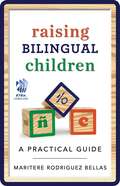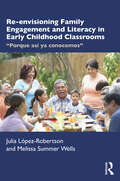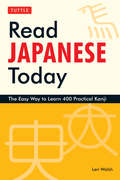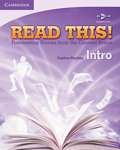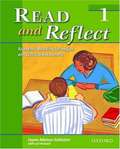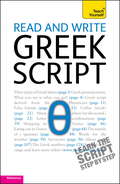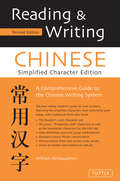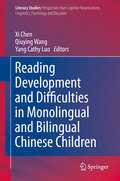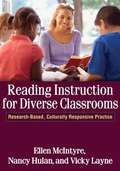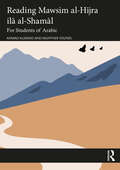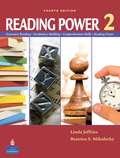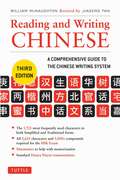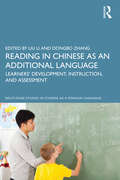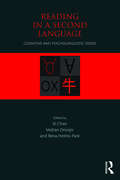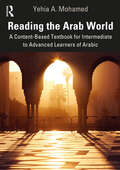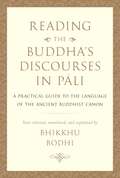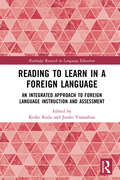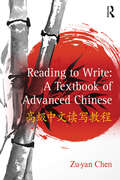- Table View
- List View
Rainbow Troops (Mandarin Edition)
by Andrea HirataIkal is a student at the poorest village school, which is under constant threat of closure. Ikal and his friends--a group nicknamed the Rainbow Troops--face threats from every angle: skeptical government officials, greedy corporations hardly distinguishable from the colonialism they've replaced, deepening poverty and crumbling infrastructure, and their own low self-confidence.But the students also have hope. 天虹战队小学 讲述了一个励志故事 在南太平洋上 有专为穷人而建的学校 条件简陋 资源匮乏 破洞比砖瓦还多 下雨天 老师要撑着香蕉叶上课 校长要卖菜为学生买课本 天才学生每天得游过鳄鱼栖息地上学 最有艺术细胞的孩子用零成本打造狂欢节演出......但他们的老师 拒绝了"前途美好"的工作 到这里教书 没有工资 靠做针线活赚取生活费 孩子们和老师一起 为了理想向命运宣战 亲身践行那句古老的格言 "那些没把你击垮的 最终只会让你更强大 "
Raising Bilingual Children: A Practical Guide
by Maritere Rodriguez BellasFor most immigrant parents in America today, raising bilingual children is not a choice or a decision, but rather a way of life. Yet teaching children their parents' native language often comes second to ensuring they are proficient in English so they can thrive in school and later reach leadership positions in the workplace. In addition, the task of teaching two (or more) languages can be overwhelming, leaving many of us wondering where to start. Raising Bilingual Children is here to help with easy, practical steps for children of every age and stage in life. Author and parenting expert Mari Bellas provides answers to questions such as: What do I do when my five-year-old doesn't want to speak Spanish at home? My husband doesn't speak Korean, so how do we find common ground to raise our kids with two languages? My child is two years old and not speaking in either of the two languages we speak at home--should I be concerned? Whether your native language is Spanish, Filipino, Korean, Chinese, or French, it is natural to want our children to communicate in the language we were born with. Raising Bilingual Children is the ultimate guidebook for busy parents looking for advice and direction about the everyday challenges and joys of raising a bilingual child.
Re-Designing Teacher Education for Culturally and Linguistically Diverse Students: A Critical-Ecological Approach (Routledge Research in Teacher Education)
by Ana Christina Da Silva IddingsThrough a critical-ecological lens, this book examines how to prepare preservice teachers to be resourceful and responsive practitioners in addressing the intellectual needs of children often labeled as "culturally and linguistically diverse." It explores a comprehensive re-design of a teacher education program grounded in research on the complex factors that affect the teaching and learning of linguistically and culturally diverse children. Re-Designing Teacher Education for Culturally and Linguistically Diverse Students challenges hegemonic cultural and linguistic norms, quantitative and static views of "resources," the impact of U.S. education policy, and the limited attention to the agency, identities, and strategic actions of diverse students and their families.
Re-envisioning Family Engagement and Literacy in Early Childhood Classrooms: "Porque así ya conocemos"
by Julia López-Robertson Melissa Summer WellsFamilies are resources that are extremely powerful and important for young learners from minoritized backgrounds, yet such families are often overlooked, silenced, or ostracized. This book presents a much-needed framework for family and community engagement in the early childhood and elementary literacy classroom that embraces and foregrounds students’ unique cultural backgrounds. This book spotlights the families of minoritized learners and the crucial role that they play in building dynamic and inspiring environments for learning. To re-envision the engagement of these families in the early childhood classroom, the book provides an accessible understanding of Yosso’s theory of community cultural wealth. Covering key topics such as children’s literature and digital tools, the book features strategies for implementing culturally responsive classroom practices to create positive home–school partnerships. Each chapter highlights one type of capital in community cultural wealth—aspirational, linguistic, familial, social, navigational, and resistant—and gives teachers guidance on working with and supporting the efforts of families both inside and outside of the classroom. This book is an essential resource to inform current and future early childhood educators on how to gain deeper understandings of what families—especially from Communities of Color—already are doing for the education of their children, and how best to support them.
Read Japanese Today
by Len WalshThis is the quickest way to effectively learn written Japanese. Japanese characters, called kanji, often intimidate potential students of the language with their complex and mysterious appearance. Read Japanese Today is a comprehensible and story-like approach to an often difficult language. Intended for people on the go, this book will teach you to recognize and read the 400 most commonly used Japanese kanji characters. Completely revised and expanded and featuring 25 percent more kanji than previous editions, Read Japanese Today is a fun way to demystify the beautiful Japanese language. Far from being complex and mysterious, Japanese kanji are actually a simple and fascinating pictographic system, easily understood and readily mastered. With the approach used in this easy-to-read, entertaining book, you'll soon be able to recognize and read more than 400 kanji, whether or not you have any knowledge of Japanese grammar or the spoken language. The kanji characters stick in your mind thanks to an engaging text and illustrations that show how each character developed and what it represents. The description for each kanji explains its origin, its modern meaning, and how it is pronounced. Many examples of everyday usage are included. Read Japanese Today also includes: A brief history of the Japanese writing system. Explanations for how the parts of each kanji are related to the whole. Guidelines for writing Kanji and pronouncing words using them. An introduction to the Japanese hiragana and katakana syllabaries. A complete index to English meanings and a summary table for all of the kanji that are introduced in the book.
Read Japanese Today
by Len WalshThis is the quickest way to effectively learn written Japanese.Japanese characters, called kanji, often intimidate potential students of the language with their complex and mysterious appearance. Read Japanese Today is a comprehensible and story-like approach to an often difficult language. Intended for people on the go, this book will teach you to recognize and read the 400 most commonly used Japanese kanji characters. Completely revised and expanded and featuring 25 percent more kanji than previous editions, Read Japanese Today is a fun way to demystify the beautiful Japanese language.Far from being complex and mysterious, Japanese kanji are actually a simple and fascinating pictographic system, easily understood and readily mastered. With the approach used in this easy-to-read, entertaining book, you'll soon be able to recognize and read more than 400 kanji, whether or not you have any knowledge of Japanese grammar or the spoken language. The kanji characters stick in your mind thanks to an engaging text and illustrations that show how each character developed and what it represents. The description for each kanji explains its origin, its modern meaning, and how it is pronounced. Many examples of everyday usage are included. Read Japanese Today also includes: A brief history of the Japanese writing system. Explanations for how the parts of each kanji are related to the whole. Guidelines for writing Kanji and pronouncing words using them. An introduction to the Japanese hiragana and katakana syllabaries. A complete index to English meanings and a summary table for all of the kanji that are introduced in the book.
Read Japanese Today: The Easy Way to Learn 400 Practical Kanji
by Len WalshThis is the quickest way to effectively learn written Japanese.Japanese characters, called kanji, often intimidate potential students of the language with their complex and mysterious appearance. Read Japanese Today is a comprehensible and story-like approach to an often difficult language. Intended for people on the go, this book will teach you to recognize and read the 400 most commonly used Japanese kanji characters. Completely revised and expanded and featuring 25 percent more kanji than previous editions, Read Japanese Today is a fun way to demystify the beautiful Japanese language.Far from being complex and mysterious, Japanese kanji are actually a simple and fascinating pictographic system, easily understood and readily mastered. With the approach used in this easy-to-read, entertaining book, you'll soon be able to recognize and read more than 400 kanji, whether or not you have any knowledge of Japanese grammar or the spoken language. The kanji characters stick in your mind thanks to an engaging text and illustrations that show how each character developed and what it represents. The description for each kanji explains its origin, its modern meaning, and how it is pronounced. Many examples of everyday usage are included. Read Japanese Today also includes: A brief history of the Japanese writing system. Explanations for how the parts of each kanji are related to the whole. Guidelines for writing Kanji and pronouncing words using them. An introduction to the Japanese hiragana and katakana syllabaries. A complete index to English meanings and a summary table for all of the kanji that are introduced in the book.
Read This! Intro Student's Book: Fascinating Stories From The Content Areas
by Daphne MackeyRead This! is a four-book reading series designed for adult and young adult ESL students at the high beginning to intermediate levels. Read This! Intro contains fifteen fascinating stories relating to the fields of Education, Sociology, Science, Marketing, and TV and Film Studies. For example, students read about schools in which students, not teachers make the rules; apartments that are designed to be difficult to live in; and reality TV shows in which the audience likes the meanest judges the best. These non-fiction stories are written in an accessible narrative style and are appropriate for high beginning students. Illustrated with attractive color photos, this low-level reading book will motivate even the lowest level reading students to start reading content-rich texts.
Read and Reflect 1: Academic Reading Strategies and Cultural Awareness
by Jayme Adelson-Goldstein Lori HowardThis book is ideal for young adults planning to pursue a college education; however, it can also be used by students who want to improve their reading skills to attain a personal goal or to advance in the workplace.
Read and write Greek script: Teach Yourself
by Sheila Hunt Dennis CouniacisMaster Greek script with this straightforward guide from Teach Yourself - the No. 1 brand in language learning. Read and write Greek script is a clear step-by-step guide to the written language, with plenty of examples from real-life texts to show how it works in context and lots of exercises to reinforce your learning. This new edition has an easy-to-read page design.Now fully updated to make your language learning experience fun and interactive. You can still rely on the benefits of a top language teacher and our years of teaching experience, but now with added learning features within the course and online. Learn effortlessly with new, easy-to-read page design and interactive features: NOT GOT MUCH TIME?One, five and ten-minute introductions to key principles to get you started.AUTHOR INSIGHTSLots of instant help with common problems and quick tips for success, based on the author's many years of experience.USEFUL VOCABULARYEasy to find and learn, to build a solid foundation for speaking.TEST YOURSELFTests in the book and online to keep track of your progress.EXTEND YOUR KNOWLEDGEExtra online articles at: www.teachyourself.com to give you a richer understanding of the culture and history of Greece.TRY THISInnovative exercises illustrate what you've learnt and how to use it.
Reading & Writing Chinese Simplified Character Edition
by William McnaughtonReading and Writing Chinese has been the best-selling standard reference text for foreign students and teachers of Chinese for the last 25 years. Now completely revised with modern (simplified) characters, it draws on the lesons learned from the use for the book in classrooms to provide a convenient and up-to-date introduction to the Chinese writing system. Materials are organized in units of progressive difficulty and complexity, with clear definitions of the individual characters presented in a logical and systematical sequence.For each of the basic 1,067 characters, the pronunciation and core meanings are given, along with examples of its use in common compounds and a stroke-order diagram showing how to write it correctly. Memorization tips and cross-references to look-alike characters are also provided. Charts of modern and traditional radicals, necessary to look up words in comprehensive Chinese dictionaries, are printed inside the front and back covers.
Reading Development and Difficulties in Monolingual and Bilingual Chinese Children
by Xi Chen Qiuying Wang Yang Cathy LuoThis volume explores Chinese reading development, focusing on children in Chinese societies and bilingual Chinese-speaking children in Western societies. The book is structured around four themes: psycholinguistic study of reading, reading disability, bilingual and biliteracy development, and Chinese children's literature. It discusses issues that are pertinent to improving language and literacy development, and complex cognitive, linguistic, and socio-cultural factors that underlie language and literacy development. In addition, the book identifies instructional practices that can enhance literacy development and academic achievement. This volume offers an integrative framework of Chinese reading, and deepens our understanding of the intricate processes that underlie Chinese children's literacy development. It promotes research in reading Chinese and celebrates the distinguished and longstanding career of Richard C. Anderson.
Reading Greek
by Joint Association of Classical TeachersThe JACT Reading Greek Course has been written for beginners in the upper school, at university and in adult education. It aims to enable students to read fifth- and fourth-century Attic Greek, Homer and Herodotus, with some fluency and intelligence in one to two years. The main medium of learning is a continuous, graded Greek text, adapted from original sources.<P><P> Advisory: Bookshare has learned that this book offers only partial accessibility. We have kept it in the collection because it is useful for some of our members. To explore further access options with us, please contact us through the Book Quality link on the right sidebar. Benetech is actively working on projects to improve accessibility issues such as these.
Reading Instruction for Diverse Classrooms
by Nancy Hulan Ellen McintyreThis practical, teacher-friendly book provides indispensable guidance for implementing research-based reading instruction that is responsive to students' diverse cultural and linguistic backgrounds. Structured around the "big five" core topics of an effective reading program phonemic awareness, phonics, fluency, vocabulary, and comprehension the book explains tried-and-true teaching strategies for fostering all students' achievement. Key topics include engaging diverse students in classroom discussion, involving families in learning, and assessing and teaching new literacies. Numerous classroom examples demonstrate a wide range of easy-to-implement lesson ideas and activities for students at different grade levels, including struggling learners. Issues specific to English language learners are woven throughout the chapters.
Reading Mawsim al-Hijra ilā al-Shamāl: For Students of Arabic
by Munther Younes Ahmad AlswaidReading Mawsim al-Hijra ilā al-Shamāl: For Students of Arabic is intended for advanced students of Arabic who have studied the language for at least two years at college level or the equivalent. The book is based on Tayeb Salih’s novel Mawsim al-Hijra ilā al-Shamāl, a masterpiece in modern Arabic literature. This book is designed to accompany the novel, which the authors divided into 60 parts, each of which consists of 400–500 words of the original text. A lesson is built on each part and starts with a reference to the first and last sentences in it. This is followed by a list of new vocabulary and a variety of activities and exercises, some oral and some written, whose goal is to develop students’ listening, speaking, reading, and writing skills and knowledge of Arabic language, culture, and literature. The book ends with a glossary of literary terms. The book’s e-resources include a comprehensive glossary of words arranged by root, a glossary of expressions, and other resources. The book can be used as a main or a supplementary text in an Arabic language course or for independent study.
Reading Medieval Latin
by Keith SidwellReading Medieval Latin is an introduction to medieval Latin in its cultural and historical context and is designed to serve the needs of students who have completed the learning of basic classical Latin morphology and syntax. (Users of Reading Latin will find that it follows on after the end of section 5 of that course. ) It is an anthology, organised chronologically and thematically in four parts. Each part is divided into chapters with introductory material, texts, and commentaries which give help with syntax, sentence-structure, and background. There are brief sections on medieval orthography and grammar, together with a vocabulary which includes words (or meanings) not found in standard classical dictionaries. The texts chosen cover areas of interest to students of medieval history, philosophy, theology, and literature.
Reading Power 2 (Fourth Edition)
by Beatrice S. Mikulecky Linda JeffriesReading Power 2 is a new and updated edition of the successful student-centered reading skills textbook Reading Power. Its unique structure, featuring four parts to be used concurrently, allows low-intermediate-level students (with a 600-word vocabulary) to develop the multiple sills and strategies involved in the reading process. Overview Extensive Reading helps students to build reading fluency, broaden knowledge of vocabulary and collocation, and gain confidence. Vocabulary Building offers strategies for independent vocabulary learning such as dictionary work, guessing meaning from context, and learning how words work in sentences. Comprehension Skills teaches reading skills such as recognizing words and phrases, scanning for information, and making inferences. Reading Faster builds awareness of reading speed, provides strategies and exercises for increasing speed, and offers charts for tracking progress. New to the Fourth Edition An updated Extensive Reading section with a unit on fiction and non-fiction reading, more activities for evaluating student progress, and a revised suggested reading list Enhanced vocabulary features including new "Focus on Vocabulary" exercises and an expanded Vocabulary Building section There is also a Teacher Guide with Answer Key and a Test Booklet for Reading Power 2. The Reading Power series also includes: Basic Reading Power 1 (Third Edition): Beginning Reading Power 2 (4th Edition): Intermediate More Reading Power 3: High-Intermediate Advanced Reading Power 4: Advanced
Reading and Writing Chinese
by William Mcnaughton Jiageng FanThis is a compete and easy-to-use guide for reading and writing Chinese characters.Used as a standard by students and teachers in learning Chinese for more than three decades, the bestselling Reading & Writing Chinese has been completely revised and updated. Reading & Writing Chinese places at your fingertips the essential 1,725 Chinese characters' up-to-date definitions, derivations, pronunciations, and examples of correct usage by means of cleverly condensed grids. This guide also focuses on Pinyin, which is the official system to transcribe Hanzi, Chinese characters, into Latin script, now universally used in mainland China and Singapore. Traditional characters (still used in Taiwan and Hong Kong) are also included, making this a complete reference.Newly updated and revised, these characters are the ones officially prescribed by the Chinese government for the internationally recognized test of proficiency in Chinese, the Hanyu Shuiping Kaoshi (HSK). Key features of this newly-expanded edition include:The 1,725 most frequently used characters in both Simplified and Traditional formsAll 2,633 characters and 5,000+ compounds required for the HSK ExamMnemonics to help with memorizationStandard Hanyu Pinyin romanizations More mnemonic phrases and etymologies to help you remember the characters An extensive introduction, alphabetical index, and index according to stroke count and stroke order Completely updated/expanded English definitions Convenient quick-reference tables of radicals Updated and revised compounds, plus 25% more vocabulary now offered Codes to assist those who are preparing for the AP exam or the HSK exam
Reading and Writing Chinese
by William Mcnaughton Jiageng FanThis is a complete and easy-to-use guide for reading and writing Chinese characters.Learning written Chinese is an essential part of mastering the Chinese language. Reading & Writing Chinese places at your fingertips the essential 1,725 Chinese characters' up-to-date definitions, derivations, pronunciations, and examples of correct usage by means of cleverly condensed grids.Newly updated and revised, these characters are the ones officially prescribed by the Chinese government for the internationally recognized test of proficiency in Chinese, the Hanyu Shuiping Kaoshi (HSK). The student's ability to read Chinese and write Chinese are reinforced throughout.Key features of this newly-expanded edition include: The 1,725 most frequently used characters in both Simplified and Traditional forms. All 2,633 characters and 5,000+ compounds required for the HSK Exam. Standard Hanyu Pinyin romanizations. More mnemonic phrases and etymologies to help you remember the characters. An extensive introduction, alphabetical index, and index according to stroke count and stroke order. Completely updated/expanded English definitions. Convenient quick-reference tables of radicals. Updated and revised compounds, plus 25% more vocabulary now offered. Codes to assist those who are preparing for the AP exam or the HSK exam.
Reading in Chinese as an Additional Language: Learners’ Development, Instruction, and Assessment (Routledge Studies in Chinese as a Foreign Language)
by Dongbo Zhang Liu LiReading in Chinese as an Additional Language focuses on Chinese literacy acquisition, which has been considered most difficult by both learners and teachers of Chinese as an additional language (CAL). Three major areas are covered: (1) acquisition of Chinese characters; (2) reading comprehension subskills and reader’s identity; (3) reading instruction and assessment. The first part delves into the foundation of Chinese literacy development—how to learn and teach Chinese characters. The second part examines various learners’ reading comprehension subskills, as well as the evolution of learners’ literacy identity. The third part explores effective instructional methods and assessment practices for CAL reading development. Theoretically, this book provides frameworks and evidence from both cognitive and sociocultural perspectives on the nature of CAL reading development. Pedagogically, the book showcases how to teach and assess CAL reading skills. Methodologically, this book includes empirical studies using both qualitative and quantitative methods. In terms of scope, the book covers a much broader spectrum of issues about CAL reading research and classroom teaching than has previously been available. Writing is also discussed in several chapters. In terms of technology, the book includes discussion on how the use of computers, the Internet, and social media impacts students’ Chinese literacy acquisition. This book will help CAL researchers and educators better understand the nature of CAL reading development and become well informed about CAL classroom teaching and assessment, including the application of interactive approaches to teaching and assessing diverse reading skills.
Reading in a Second Language: Cognitive and Psycholinguistic Issues
by Xi Chen Rena Helms-Park Vedran DronjicReading in a Second Language offers a comprehensive survey of the phenomenon and process of reading in a second language, with graduate and upper-level undergraduate students in second language acquisition, psycholinguistics, and applied psychology as its primary audience. The book explores reading processes from a number of complementary standpoints, integrating perspectives from fields such as first and second language reading, second language acquisition, linguistics, psycholinguistics, and cognitive neuroscience. The first half examines major factors in second language reading: types of scripts, the cognitive and neural substrates of reading; metalinguistic awareness, word recognition, language transfer, and lexical knowledge. The second part of the book discusses the social and educational contexts in which reading development occurs, including issues related to pedagogy, the use of technology in the classroom, reading disorders, and policy making. Reading in a Second Language provides students with a full, logically organized overview of the primary factors that shape reading development and processes in a second language.
Reading the Arab World: A Content-Based Textbook for Intermediate to Advanced Learners of Arabic
by Yehia A. MohamedReading the Arab World is a content-based textbook for intermediate to advanced students of Arabic, designed to enhance language skills through exposure to authentic texts. Students will develop their reading, writing, speaking, and critical thinking skills as they learn about the most contemporary issues shaping the Arab world through a range of authentic texts. The choice of texts and authors is diverse and includes texts from various sources and geographical regions in the Arab world, as well as authors of different genders, ages, generations, and schools of thought, thus ensuring a compelling range of viewpoints and angles. Each text is supported by relevant tasks such as vocabulary exercises, comprehension activities, and discussion questions. This is an ideal resource for students of Arabic as a second or heritage language, working at or above the Intermediate-High level on the ACTFL proficiency scale.
Reading the Buddha's Discourses in Pali: A Practical Guide to the Language of the Ancient Buddhist Canon
by Bhikkhu BodhiRenowned scholar-monk and bestselling translator Bhikkhu Bodhi&’s definitive, practical guide on how to read ancient Buddhist texts in the original language.Bhikkhu Bodhi&’s sophisticated and practical instructions on how to read the Pali of the Buddha&’s discourses will acquaint students of Early Buddhism with the language and idiom of these sacred texts. Here the renowned English translator of the Pali Canon opens a window into key suttas from the Sa?yutta Nikaya, giving a literal translation of each sentence followed by a more natural English rendering, then explaining the grammatical forms involved. In this way, students can determine the meaning of each word and phrase and gain an intimate familiarity with the distinctive style of the Pali suttas—with the words, and world, of the earliest Buddhist texts. Ven. Bodhi&’s meticulously selected anthology of suttas provides a systematic overview of the Buddha&’s teachings, mirroring the four noble truths, the most concise formulation of the Buddha&’s guide to liberation. Reading the Buddha&’s Discourses in Pali shares with readers not only exceptional language instruction but also a nuanced study of the substance, style, and method of the early Buddhist discourses.
Reading to Learn in a Foreign Language: An Integrated Approach to Foreign Language Instruction and Assessment (Routledge Research in Language Education)
by Keiko Koda Junko YamashitaThis book describes a theory-guided approach to Foreign Language (FL) course development, implementation, instruction and assessment. It documents the development and implementation of a theory-guided approach designed to exploit cross-linguistically sharable competencies as resources for promoting FL learning. The volume delineates the processes of (a) identifying cross-linguistically sharable competencies, (b) exploring ways of exploiting sharable competencies as resources in promoting language skills through their purposeful use for content learning, (c) implementing the instructional approach in multiple EFL classrooms, and (d) evaluating the approach by comparing learning outcomes across classrooms. It presents a solid conceptual framework that integrates theories in multiple research domains, including second language acquisition, knowledge acquisition, and language assessment. It also provides detailed descriptions of framework construction and classroom implementation – the two processes that are integral to course design and development.
Reading to Write: A Textbook Of Advanced Chinese
by Zu-Yan ChenTraditionally, reading and writing are believed to be separate but related language processes and teachers follow the conventional wisdom of teaching in-depth reading, with writing as a tag-on issue. Therefore, there exists an increasingly urgent call for a well-rounded reading-writing curriculum and a theoretically-informed, empirically-based, student-centered advanced textbook that aims to develop the synergy between reading and writing. Reading to Write: A Textbook of Advanced Chinese is intended to fill this significant gap. It treats reading and writing as integrative parts and interactive skills in Chinese language teaching, putting them hand-in-hand, supplementing each other.

